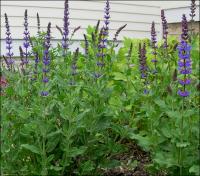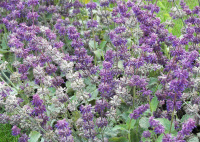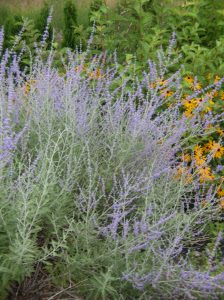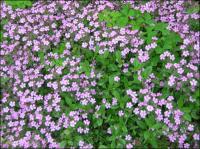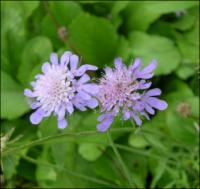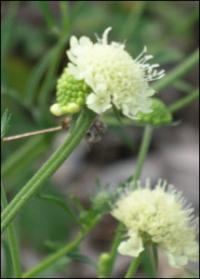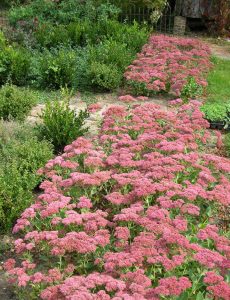Drought, Xeric & Dry Soil Plants
Showing 105–112 of 132 results
-
Salvia nemorosa Meadow sage, Balkan clary Z 5-7
Purple/lavender spire dense with flowers June to September
Dense purple spires flower June to September (if cutback after 1st flush of flowers).
Size: 36" x 24"
Care: full sun in moist well-drained to well-drained soil. Drought tolerant.
Native: Europe to Central Asia.
Wildlife Value: attracts butterflies & hummingbirdsSalvia is from the Latin word salveo meaning “to heal” referring to the plant’s ancient medicinal uses. Collected before 1753.
-
Salvia verticillata Lilac sage, whorley clary, Salbey Z 5-8
Muted lilac blue spikes June to October
Muted lilac blue spikes June to October, deadhead for more blooms.
Size: 24” x 18-24”
Care: sun in moist well-drained to well-drained soil. Cut back after first bloom to repeat.
Native: Spain to Ukraine, Caucasus to Iran
Wildlife Value: Butterfly magnet.Salvia is from the Latin “salveo” meaning “to heal” referring to the plant’s ancient medicinal uses. This species collected before 1753. Grown at America’s 1st botanic garden, Elgin Botanic Garden 1811.
-
Salvia yangii syn. Perovskia atriplicifolia Russian sage Z 5-9
Whorls of sky-blue flowers cover innumerable stems and their many branches creating a blue cloud from July through October
Whorls of sky-blue flowers cover innumerable stems and their many branches creating a blue cloud from July through October
Size: 4' x 4'
Care: full sun in moist well-drained to well-drained soil, Heat and drought tolerant. Cut back in spring.
Native: Afghanistan
Wildlife Value: deer & rabbit resistant, Feeds bees and honeybees
Awards: Great Plant Pick Award from Elizabeth Carey Miller Botanical Garden and Perennial Plant Association 1995 Perennial Plant of the Year.Perovskia was named for V.A. Perovski, governor of a Russian province in central Asia around 1890. Introduced to American gardens in 1904. Recommended by English garden maven Gertrude Jekyll in 1908.
-
Saponaria ocymoides Rock soapwort Z 4-9
Cheery pink soapwort, in late spring, hugs the ground
Cheery pink soapwort, in late spring, hugs the ground.
Size: 3" x 18"
Care: Sun, well-drained soil, cut back hard after flowering
Native: Spain to Yugoslavia
Awards: Received England’s Royal Horticultural Society Award of Merit.Both the botanical and common names come from the plant’s use as soap, the leaves “yeelde out of themselves a certain iuice when they are bruised, which scoureth almost as well as sope.” Gerard (1633). Soapwort is still used today by antique and art restorers for its gentle cleaning: chop dried leaves and roots, boil in water for 5 minutes, and then agitate to make suds. William Robinson, father of today’s mixed perennial border gardens, praised this as bearing “masses of rosy blooms.”
-
Scabiosa lucida Pincushion flower Z 4-9
Lilac pincushions all summer & fall
Lilac pincushions all summer & fall, non-stop
Size: 24" x 12"
Care: full sun in well-drained soil.
Native: Central and Eastern Europe
Wildlife Value: attracts butterfliesScabiosa from Latin scabies referring to the itch caused by a mite infestation, which another Scabiosa species allegedly cured. This species 1st described in a French publication in 1779.
-
Scabiosa ochroleuca Cream pincushion Z 4-9
June-October ivory pincushions atop wiry stems
Looking for a non-stop bloomer? June-October ivory pincushions atop wiry stems
Size: 18"-24" x 18"
Care: sun to part shade in moist well-drained soil. Drought tolerant.
Native: Europe & Asia
Wildlife Value: attracts butterfliesThe name scabiosa from Latin scabies refers to the mite infestation that this plant was supposed to cure; ochroleuca means “yellowish white.” First described by Bauhin Caspar in Pinax theatri botanici in 1623.
-
Schizachyrium scoparium syn. Andropogon scoparium Little bluestem Z 3-9
Wispy, feather-like seedheads atop blue-grey foliage that turns plum-orange-red in fall.
Wispy, feather-like seedheads atop blue-grey foliage that turns plum-orange-red in fall
Size: 18" x 12"
Care: sun in well-drained soil.
Native: all No. America
Wildlife Value: leaves food for Skipper butterfly caterpillars and seeds food for songbirdsFirst collected by French plant hunter André Michaux in America’s prairies c. 1790. Comanche used it to remedy syphilitic sores. Lakota made soft, wispy seedheads into liners for moccasins.
-
Sedum ‘Autumn Joy’ syn ‘Herbstfreude’ syn Hylotelephium ‘Autumn Joy’ Z 4-9
Classic, large flat flower heads turn from green to rose
Classic, large flat flower heads turn from green to rose blooming in September and October. A staple for autumn in the garden.
Size: 30” x 12”
Care: full sun in well-drained soil
Awards: England’s Royal Horticultural Society Award of Garden Merit.Sedum means “plant that sits.” “Live forever” is an ancient Greek name for sedums. The Roman Pliny claimed that sedum’s juice treated wounds. In the 1500’s English herbalist Gerard called sedums “very full of life,” referring to succulent’s quality of being very easy to grow. Autumn Joy introduced to gardens before 1920 by the George Arends Nursery in Ronsdorf, Germany.

